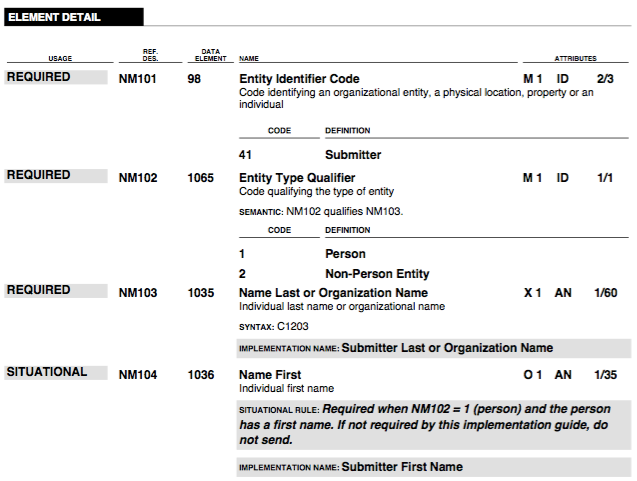Be sure you start with the right documentation, which must be purchased from ASC X12. Documentation from a trading partner might be usable in a pinch, but is often missing details or has details relevant only to that partner. If you are unsure, the cover page for the document should look like this:

Tables
The overall structure of the grammar is given in section 2.2 of the
documentation (be sure it is marked IMPLEMENTATION and not STANDARD). The
top-level tables can be written as TableDef.header, TableDef.detail, and
TableDef.summary.

Note for some reason, some grammars show the
SEsegment at the end of a detail table, rather than in its own summary table. TheSEsegment is the end of the document, so when you code up the grammar, you should create aTableDef.summaryto contain theSEsegment (see 837P). This is because a detail table can be repeated, while a summary table cannot, and theSEsegment should only occur once in a document.
Loops
Loops are groups of segments which have a particular starting segment that
indicates the start of the group, followed by other segments. Loops may be
nested, and each loop may be repeated a specified number of times. You can
translate each loop in the documentation to a LoopDef.build(name, repeat_count,
*children) where children are either segments or child loops.
In the example above, the "2000C PATIENT HIERARCHY" loop has a repeat count
of RepeatCount.unbounded, child segments HL and PAT, and many child loops
beginning with "2000CA PATIENT NAME". Since HL is the first segment in the
loop, when the parser reads an HL in the right context, it will then create
the corresponding loop in the parse tree.
Segments
Segments are sort of like a struct in the C programming language, where the
fields are called elements. Unlike structs, each time a segment occurs in the
grammar, it can be given a different name, different flags to indicate which
fields are required or optional, different set of allowed values in each field,
and a different number of allowed repeats.
One of the most commonly used segments is NM1, which is generally some kind of
name. In the above example, you an NM1 Patient Name, but there are many others
in the grammar for different people.

The important parts of the image above have probably already been transcribed in
an existing SegmentDef (unless you find a segment that hasn't been defined), which
are the same across all grammars (all the X12 attributes). The "loop", "usage", and
"repeat count" were described earlier, but are again shown here.
Segments can be described using BuilderDsl.Segment(offset, id, name,
usage, repeat_count, *elements). The first argument comes from the Pos. #
column in the table diagram above. For instance, the NM1 Patient Name segment
has an offset of 150. The usage argument is denoted in a few places: on the
above diagrams, it is the labeled Usage; this indicates if the segment is
required or optional, or if its presence depends on other conditions.
Elements
Elements are (apart from composite elements), some kind of atomic data type, like a string, number, date, etc. Each place a segment is specified in the grammar, its element properties are also specified. Beware that each place that a segment appears can have different details about its elements, per-occurence.

This diagram indicates some of the properties of each element, in this
particular instance of the NM1 segemnt. The bold border around an element
indicates that it is Required, while strike-through text indicates a
NotUsed. If you encounter a segment that hasn't already been defined, some of
the other properties needed to define the segment are also included on the
diagram, but we'll ignore those for now.

The third section of each element detail gives a name to each element,
usually in the gray section labeled IMPLEMENTATION NAME, and also specifies
its usage, allowed values, and minimum and maximum lengths. The usage indicator
is in the first column, name and allowed values in the fourth. Minimum and
maximum length, and number of decimal places are given in the last column, but
these rarely need to be specified as they are usually the same as the default
declared in the ElementDef.